The appearance of stinging nettles in my neighborhood is exciting, because it marks the beginning of the foraging season! Last year, spring came in so late that we were desperate enough to go collect nettles that had just barely broken out of the frozen ground. We brewed beer with them and found some fun ways to eat nettles, too. That was our first real experience working with nettles, and this year we want to do a whole lot more!
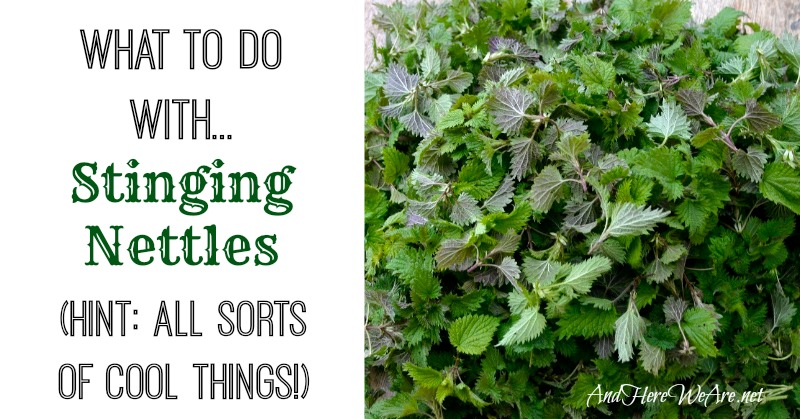
For those of you who have nettles growing in your area, you should definitely take advantage of this fantastic plant! It can be used as a super-nutritious food, as an herbal remedy (awesome for those suffering seasonal allergies) as a beauty aid, and even to help your garden!
I will show you what I do with stinging nettles, and then point you to some great ways to use them! Many fancy markets or farmers’ markets will sell stinging nettles, but I like to gather them myself. Foraging for nettles is fun, and a really nice way to spend a Sunday afternoon with your family or some friends. Here are some extra tips on identification, in case you are unsure.
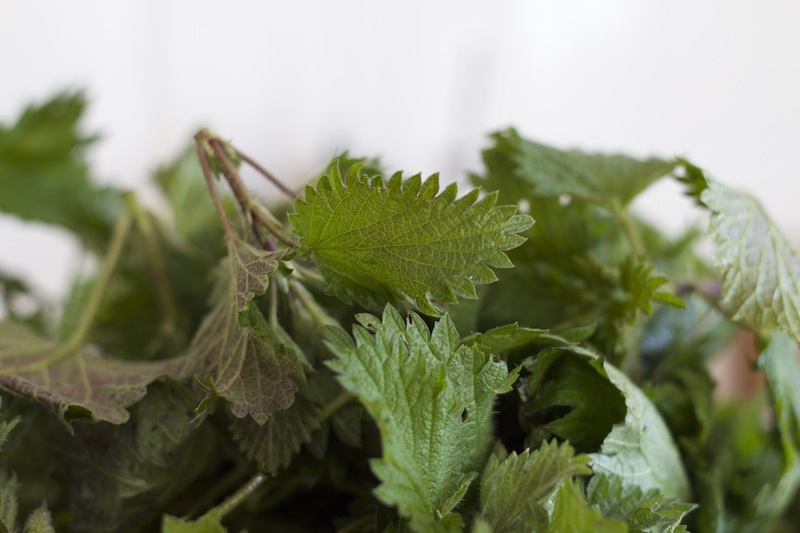
What to Do with Stinging Nettles
Once you have gathered about a bucket-full (we take a big grocery bag or two when we gather them) it’s time to process them. Using gloves and/ or kitchen tongs, give them a good rinse. I usually fill a big metal bowl with cold water and add some white vinegar to it. I do this because– let’s face it– animals pee on plants in the wild. It could be dogs, foxes, or maybe the toddler who just couldn’t hold it– who knows? I try not to be squeamish about this, but adding the vinegar and giving them a good wash makes me feel better. Swish the stinging nettles around in the water, and change it once or twice.
 While you’re washing the nettles, get a big pot of water on the stove and bring it to a boil.
While you’re washing the nettles, get a big pot of water on the stove and bring it to a boil.
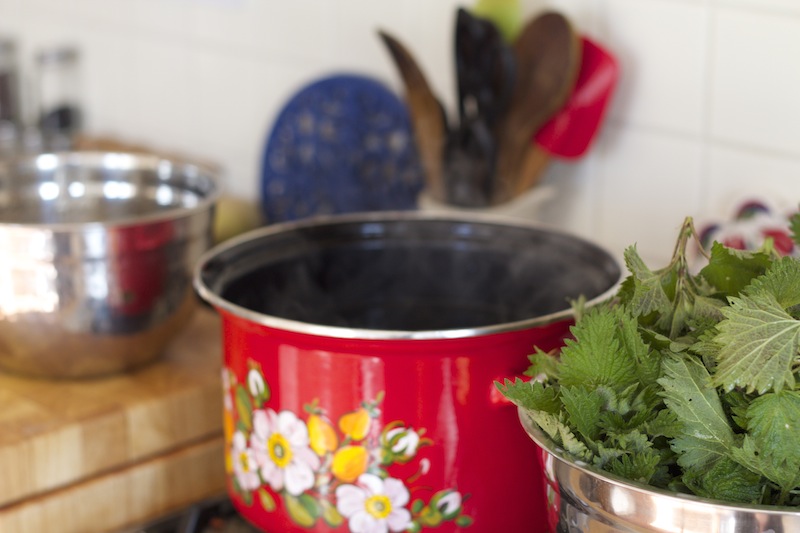 Take big bunches of nettles with your tongs and put them in the boiling water. Let them cook for about a couple of minutes until limp, then transfer to another bowl. After you have blanched them like this, they can no longer sting you.
Take big bunches of nettles with your tongs and put them in the boiling water. Let them cook for about a couple of minutes until limp, then transfer to another bowl. After you have blanched them like this, they can no longer sting you. 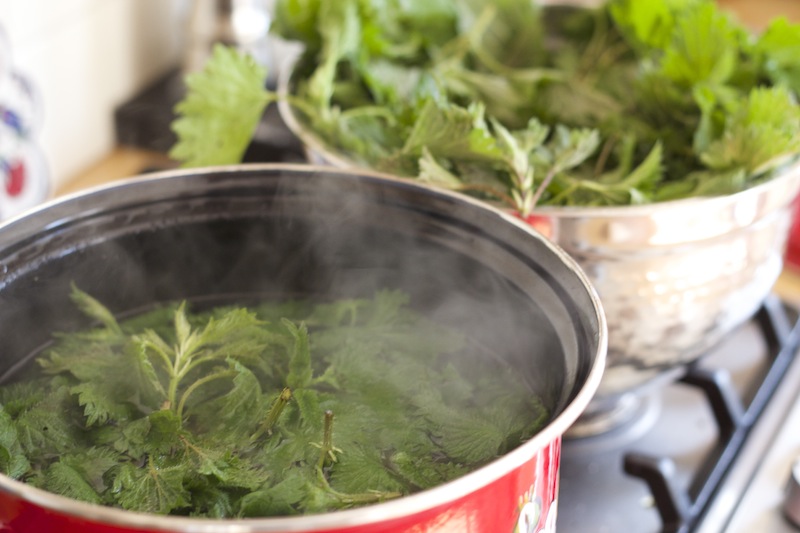

 Once you have finished blanching all of them, press more of the water out of them (back into the pot, I’ll explain later) and move them to the bowl of a food processor. If you are using a blender, then leave the liquid in. Alternatively, you could dry them in a clean dish towel and roughly chop them up with a knife.
Once you have finished blanching all of them, press more of the water out of them (back into the pot, I’ll explain later) and move them to the bowl of a food processor. If you are using a blender, then leave the liquid in. Alternatively, you could dry them in a clean dish towel and roughly chop them up with a knife.
Process them until reasonably smooth and uniform. To make an awesome Stinging Nettles Dip you can start with them just like this, in the food processor. When I worked with them this time, I took half and put them in silicone baking molds (I use these for everything– big fan!) to freeze, and left half to make dip with.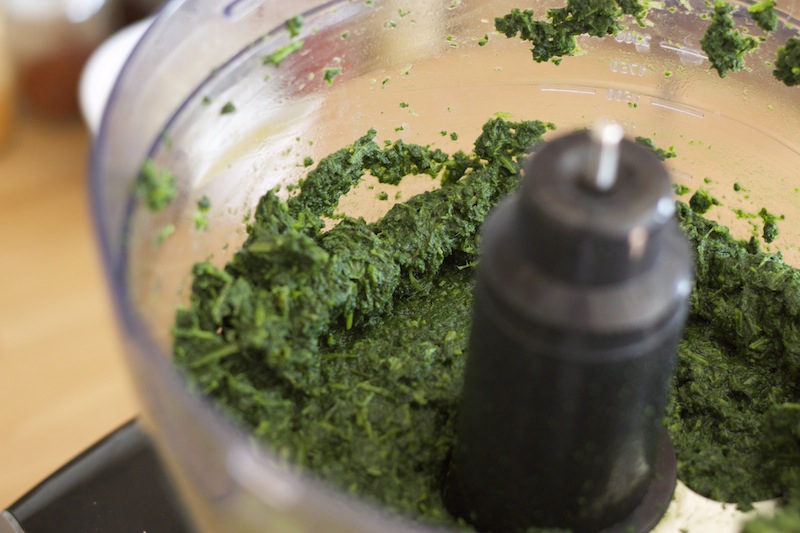
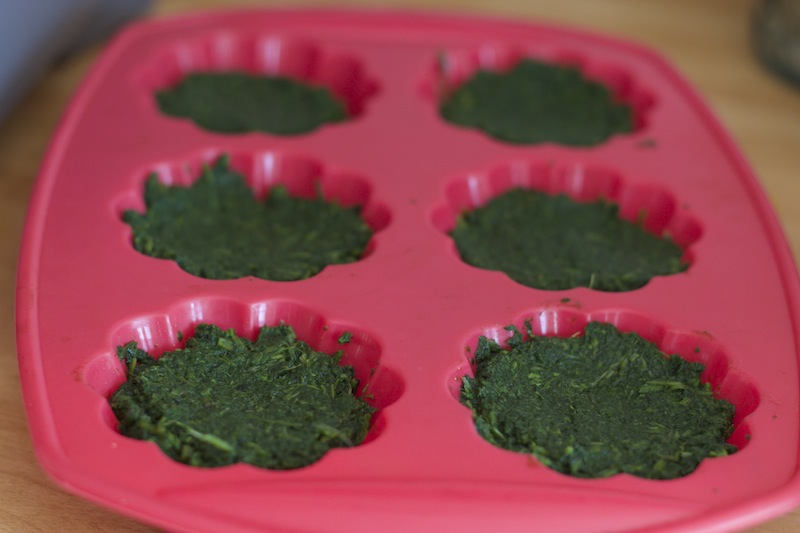 Put the molds into the freezer, and then when they are firm, pop them out and store these discs in a ziplock bag to use in soups, dips, and all sorts of things — see recipes below!
Put the molds into the freezer, and then when they are firm, pop them out and store these discs in a ziplock bag to use in soups, dips, and all sorts of things — see recipes below!
Nettles Tea
Now, all of that water you have left in your blanching pot is nettles tea! We use it for Making Wild Nettles Beer, and we have also made wine with it. You can also just drink it. Some people ferment it slightly first. Yesterday, I strained mine into bottles and put it in the fridge. If you sweeten some with local raw honey, then you will have a powerful tonic for fighting seasonal allergies.
Other uses and benefits of nettles tea include:
- Increasing milk supply for nursing mothers
- Healing mouth and throat infections when used for gargling
- Clearing acne and blemishes when applied to the face like a toner
- Healing eczema when applied to the skin
- Nourishing hair to make it shinier and more healthy when you use it as a rinse
- Easing aches and pains when added to a bath
- Strengthening nails, skin and hair because it is rich in silica
- Some even use it as a liquid multivitamin
Recipes for Using Nettles
Not only are nettles super nutritious and tasty, but they are beautiful. Nettles produce an emerald green soup like no other plant I know. There are lots of ways to use them, and you can substitute them just about anywhere you would use spinach, once blanched. Here just some of the possibilities:
- Chicken & Stinging Nettle Soup
- Nettles Soup with Creme Fraiche
- Wild Onion & Stinging Nettle Soup
- Stinging Nettle & Spring Garlic Soup
- Stinging Nettles Omelette
- Ramp & Nettle Butter
- Nettle & Ramp Pesto (Dairy-Free)
- Stinging Nettles Dip with Roasted Garlic & Mint
- Making Wild Nettles Beer
- Pickled Marinated Nettles
- You can also simply add raw nettles when you are juicing
Other Uses for Nettles
- You can use nettles as a compost activator, speeding up the metabolic process so it “cooks” faster
- Adding some cooked nettles to chicken feed increases egg production from your flock
- Nettles also increases milk production when fed to your milk cows
- Fed to any of your animals, it will nourish their fur, feathers, or coat
We are so lucky to have such a powerful and useful plant growing for free in our midst. I hope you’ll get out there and collect some nettles this spring! They are best while they are young, and not much good to eat after mid-June.
Did you Enjoy this post? Share it with someone, and pin for later!
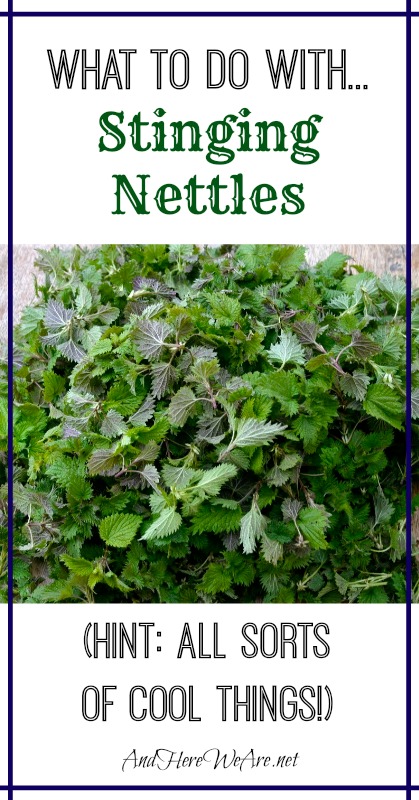
Sources: https://www.dryit.com/nettles.html


I just realized we have these growing on the property and I thought they were berries! Sounds like I have some experimenting to do.
Ooh, fun! Yes– there’s lots to try with these, lucky you!
This is a GREAT post! Thank you for linking to my fermented nettle tea! 🙂
Yes, I was happy to share such a great idea, Jessica!
I make the most beautiful pasta with Stinging Nettles. It turns a light mint green color with darker green speckles. So Pretty! And So Healthy!
Yes– I LOVE the rich color you can get from nettles, so beautiful!
Living on the coast of the Pacific Northwest was to live in a foraging wonderland. People have little idea of how much wholesome, tasty food is in their own back yard. It’s remarkable and much of it tastes even better than the bland things we buy in stores.
As an aside, here is a foraging stick I designed and made for such hunts:
https://www.flickr.com/photos/functional_art/2747549310/
Well, that is a SUPER cool foraging stick!! What an awesome talent! You know, when I lived in Portland for three years, I do not recall ever coming across stinging nettles. But I’m sure it is just because I didn’t have them on my radar, and didn’t know what to look for. So glad to hear you’re taking advantage.
Nettles are literally everywhere here in rural Suffolk. So it cracked me up to see my local organic farm stand at the market selling bags of them. Ignorance about wild food can be very expensive!
Wow, and honestly I just thought they were horrible annoying plants that I’ve been trying to “kill off” in my backyard. The kids go out to play and come back with big red welts. Maybe now I will just pull them up and have a good use for them. (I have a whole back yard full). I’ll definitely have to try some of this!
Yeah…my favorite weed 😐 I grabbed a (bare) handful just last week while weeding the garlic bed. Are all varieties edible?
There’s also this use: https://www.facebook.com/StillRiverMill?fref=nf
I enjoy them with long grain rice and a dash of cayan pepper!
glad to know its eatable
Where can I buy the plant? Thank you
Go out for a country walk and pick them free. I could offer to pick some and sell them to you, but would rather you learn, identify and enjoy.
mine grow nicely in the shade. i have several patches in many different places. do birds or other animals spread them?
If you desire to increase your familiarity only keep visiting this website and be updated
with the newest news posted here.